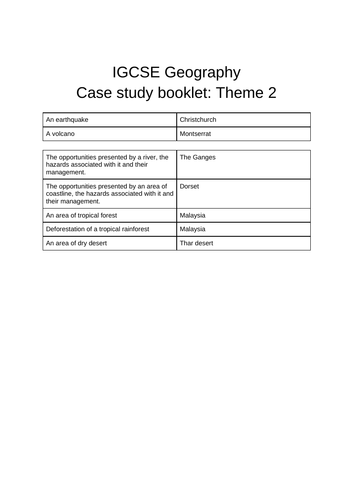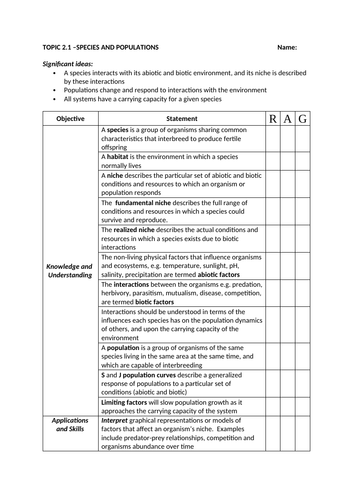39Uploads
5k+Views
2k+Downloads
All resources

CIE GCSE Geography - 7 mark questions organised by theme
What it says on the tin - a list of all the past 7 mark questions which have come up on cambridge GCSE Geography paper 1, organised by theme.
A great planning and revision resource.

ESS (IBDP) 1.1 environmental value systems unit of work
Full lessons for IB ESS topic 1: ready to pick up and teach - no extra planning needed.
Covers:
• Signifcant historical infuences on the development of the environmental
movement have come from literature, the media, major environmental
disasters, international agreements and technological developments.
• An EVS is a worldview or paradigm that shapes the way an individual, or
group of people, perceives and evaluates environmental issues, infuenced by
cultural, religious, economic and sociopolitical contexts.
• An EVS might be considered as a system in the sense that it may be
infuenced by education, experience, culture and media (inputs), and involves
a set of interrelated premises, values and arguments that can generate
consistent decisions and evaluations (outputs).
• There is a spectrum of EVSs, from ecocentric through anthropocentric to
technocentric value systems.

ESS (IBDP) 1.2 Systems and models unit of work
Full lessons for IB ESS topic 1: ready to pick up and teach - no extra planning needed.
Covers:
• A systems approach should be taken for all the topics covered in the
ESS course.
• These interactions produce the emergent properties of the system.
• The concept of a system can be applied at a range of scales.
• A system is comprised of storages and flows.
• The flows provide inputs and outputs of energy and matter.
• The flows are processes that may be either transfers (a change in location)
or transformations (a change in the chemical nature, a change in state or a
change in energy).
• In system diagrams, storages are usually represented as rectangular boxes
and flows as arrows, with the direction of each arrow indicating the direction
of each flow. The size of the boxes and the arrows may be representative of
the size/magnitude of the storage or flow.
• An open system exchanges both energy and matter across its boundary
while a closed system exchanges only energy across its boundary.
• An isolated system is a hypothetical concept in which neither energy nor
matter is exchanged across the boundary.
• Ecosystems are open systems; closed systems only exist experimentally,
although the global geochemical cycles approximate to closed systems.

IB Diploma ESS (new course) Topic 1: Foundations - All lessons and Resources
This is an entire set of resources to teach unit 1 of the new course of IB Diploma Environmental systems and societies (first examination 2026) standard level.
This includes presentations, exam questions, group work, independent research, case studies etc. There is no additional planning needed.
1,1 Perspectives
1.1.1 Perspectives and world views
1.1.2 Influences on perspectives and world views
1.1.3 Environmental value systems
1.1.4 Environmental movements
1.2 Systems
1.2.1 Models
1.2.2 Systems approach
1.2.3 Storages and flows
1.2.4 Feedback loops and tipping points
1.2.5 Causal loop diagrams
1.2.6 Resilience
1.3 Sustainability
1.3.1 What is sustainability?
1.3.2 Environmental justice
1.3.3 Sustainability indicators
1.3.4 UN Sustainable Development Goals
1.3.5 Planetary boundaries model
1.3.6 Doughnut economics model
1.3.7. Circular economy

GCSE rivers knowledge organiser
Two sided A3 knowledge organiser, partially completed for revision. Includes detailed diagrams. Complete GCSE rivers unit - CIE but suitable for AQA and edexcel.

GCSE Geography theme 2 case study booklet
Every case study for Cambridge GCSE Geography Theme 2, including all information needed to answer 7 mark questions.
An earthquake
A volcano
The opportunities presented by a river, the hazards associated with it and their management.
The opportunities presented by an area of coastline, the hazards associated with
An area of tropical forest
Deforestation of a tropical rainforest
An area of dry desert

GCSE Geography Rivers full lessons
All lessons and resources to teach Cambridge International GCSE Rivers. No extra planning needed.
Includes:
key terms
hydrological cycle
Erosion
Transportation
Deposition
Upper, middle and lower course landforms
Causes of flooding
Flood management
River case study - hazards, opportunities and management

Converting Binary to denary lesson and worksheet
Powerpoint and worksheet (with 20 questions) to teach binary to denary conversions.
Introduces base 10 and base 2 number systems.
Worksheet with 20 questions (answers provided).
Ready to pick up and teach.

ESS (IBDP) 8.2 Resource use and society unit of work
Entire unit of work for Environmental systems and societies topic 8.2: resource use in society. Full lessons ready to teach: no extra planning needed.
This resource covers:
Renewable natural capital can be generated and/or replaced as fast as it is
being used. It includes living species and ecosystems that use solar energy
and photosynthesis, as well as non-living items, such as groundwater and the
ozone layer.
• Non-renewable natural capital is either irreplaceable or can only be replaced
over geological timescales; for example, fossil fuels, soil and minerals.
• Renewable natural capital can be utilized sustainably or unsustainably. If
renewable natural capital is used beyond its natural income this use becomes
unsustainable.
• The valuation of natural capital can be divided into the following two
main categories.
• The impacts of extraction, transport and processing of a renewable natural
capital may cause damage, making this natural capital unsustainable.
• Natural capital provides goods (such as tangible products) and services (such
as climate regulation) that have value. This value may be aesthetic, cultural,
economic, environmental, ethical, intrinsic, social, spiritual or technological.
• The concept of a natural capital is dynamic. Whether or not something has
the status of natural capital, and the marketable value of that capital varies
regionally and over time and is infuenced by cultural, social, economic,
environmental, technological and political factors. Examples include cork,
uranium and lithium.

ESS (IBDP) 8.1 human systems and resource use: unit of work
Entire planned unit of work for Environmental systems and societies, ready to pick up and teach - no extra planning needed.
Covers:
Demographic tools for quantifying human population include crude birth
rate (CBR), crude death rate (CDR), total fertility rate (TFR), doubling time (DT)
and natural increase rate (NIR).
• Global human population has followed a rapid growth curve, but there is
uncertainty as to how this may be changing.
• As the human population grows, increased stress is placed on all of the
Earth’s systems.
• Age–gender pyramids and demographic transition models (DTM) can be
useful in the prediction of human population growth. The DTM is a model
that shows how a population transitions from a pre-industrial stage with high
CBRs and CDRs to an economically advanced stage with low or declining CBRs
and low CDRs.
• Infuences on human population dynamics include cultural, historical,
religious, social, political and economic factors.
• National and international develo

ESS IBDP 8.3 : Solid domestic waste unit of work
Complete, high quality lessons covering environmental systems and societies unit 8.3: solid domestic waster. Ready to pick up and teach, no extra planning needed and exam practice included.
Different types of solid domestic waste
The abundance and prevalence of non-biodegradable pollution
The linear vs circular economy
Waste disposal options include landfills, incineration, recycling
and composting.

ESS (IBDP) 1.4 Sustainability: unit of work
Whole set of high quality lessons for Environmental systems and societies unit 1.4 Sustainability
Covers:
Sustainability
Ecological overshoot
Ecological foot print
Natural capital: goods and services
Environmental impact assessments

ESS IBDP 8.4: Carrying Capacity unit of work
Carrying capacity is the maximum number of a species, or “load” that can be sustainably supported by a given area.
It is possible to estimate the carrying capacity of an environment for a given species; however, this is problematic in the case of human populations for a number of reasons.
An EF is the area of land and water required to support a defined human population at a given standard of living. The measure of an EF takes into account the area required to provide all the resources needed by the population, and the assimilation of all wastes.
EF is a model used to estimate the demands that human populations place on the environment.
EFs may vary significantly by country and by individual and include aspects such as lifestyle choices (EVS), productivity of food production systems, land use and industry. If the EF of a human population is greater than the land area available to it, this indicates that the population is unsustainable and exceeds the carrying capacity of that area.
Degradation of the environment, together with the consumption of finite resources, is expected to limit human population growth.
If human populations do not live sustainably, they will exceed carrying capacity and risk collapse.

ESS IBDP Unit 2 Guided revision/workbook
A set of guided revision booklets, or a set of workbooks to use in class covering all of Environmental Systems and Societies Unit 2. 47 pages total.
Includes RAG grids, diagrams,key terms, questions and instructions on note taking.
2.1: species and populations
2.2 Communities and ecosystems
2.3 Flows of energy and matter
2.4 Biomes, zonation succession
2.4 Investigating ecosystems

ESS IBDP 2.1 Ecosystems and ecology (power point and workbook)
Complete set of resources for environmental systems and societies unit 2.1; power point and workbook.
Ready to pick up and teach no planning needed.
Includes: Ecosystem key terms
Population dynamics and limiting factors (J and S curves)
Interactions: Predation, herbivory, parasitism, mutualism, disease and competition

Christmas Geography quiz 2023
An end of term Christmas/Geography quiz covering:
Christmas Geography
Events of 2023
Unusual Geography
World food
Cultural Geography
Currency
World landmarks
Artists and bands
Famous explorers
Ten questions for each round, followed by the answers

ESS IPDP 1.5 Unit of work
Whole set of high quality lessons for Environmental systems and societies 1.5 : Humans and Pollution.
Bundle

IB DP Environmental Systems and Societies Unit 1: All Lessons
This is a complete set of resources to teach IB Diploma unit 1. It includes power points, case studies, group work and essay practice. It also includes exam style questions.
1.1 Environmental value systems
1.2 Systems and models
1.3 Energy and equillibria
1.4 Sustainability
1.5 Humans and pollution
Bundle

IBDP ESS unit 8: entire unit of work (powerpoints and resources)
All of the resources needed to teach Environmental Systems and Societies Unit 8: Human systems and resource use.
No planning needed - high quality resources



















